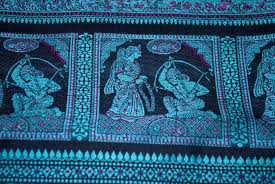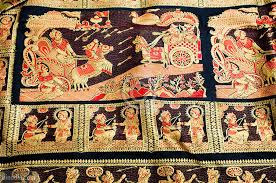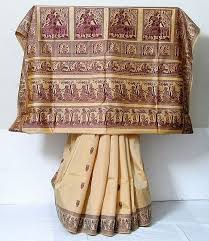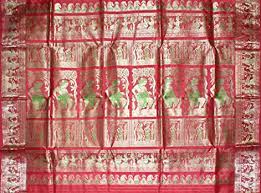Baluchari Sarees Handloom Silk of Bishnupur Bankura India
- viewsites
- Dec 19, 2023
- 3 min read
Updated: Dec 21, 2024
Baluchari sari
Baluchari Sari (Bengali: বালুচরী শাড়ি) is a type of sari, a garment worn by women in Bangladesh and Indian states of West Bengal, Tripura and Assam. This particular type of sari originated in West Bengal and is known for depictions of mythological scenes on the anchal of the sari. It used to be produced in Murshidabad but presently Bishnupur and its surrounding areas of West Bengal are the only place where authentic Baluchari saris are produced. It takes approximately one week to produce one such sari. In 2011, the Baluchari Sari was granted the status of Geographical Indication for West Bengal in India.
Baluchari saris, or locally called Baluchari saris, today often have depictions from scenes of Mahabharat and Ramayana. During the Mughal and British eras, they had a square design in the pallu with paisley motifs in them, and depicted scenes from the lives of the Nawab of Bengal featuring women smoking hookahs, nawabs driving horse carriages, and even European officers of the East India Company. It would take two craftsmen working for almost a week to produce one sari. The main material used is silk and the sari is polished after weaving.
Baluchari saris illustrate Hindu mythological scenes, nature, folklore, legends, historical events, and abstract designs. They showcase gods, heroes, nature elements, love stories, battles, and contemporary patterns.
While there isn’t a lot of variation in the method of weaving used today, balucharis can be broadly categorized based on the threads used in weaving the patterns:
Baluchari (resham): The simplest balucharis have resham threads in a single colour to weave the entire pattern
Baluchari (meenakari): These balucharis have threads in two or more colours with attractive meenakari work that further brightens the patterns
Swarnachari (baluchari in gold): They are the most gorgeous balucharis, woven with gold (swarna) or silver coloured threads (often with meenakari work in another colour), which is called Zari. That illuminate the patterns to a much larger extent.
The Weaving Technique
The original baluchari sarees in Murshidabad in the 18th and 19th centuries were woven on the traditional jala looms, where jala refers to the reference design which is first made, and is used as the master design from which many copies can be made repetitively for weaving the sarees. The process was very elaborate, taking between 15-18 weeks to weave a saree and gave rise to a large variety of very intricate patterns. During the revival of baluchari weaving in the 20th century by the artist Subho Thakur, jala was replaced by the jacquard technique of weaving. Here, the design is first drawn on a graph paper and then punched into cards accordingly. These cards are then arranged sequentially, sewed together and finally fixed into the jacquard machines. The jacquard technique is simpler and faster, reduces the weaving time to 1 or 2 weeks, but is not as flexible as the jala technique and cannot produce patterns with as much diversity or intricacy. This is the technique that is used in modern times to weave baluchari sarees.
To know more, visit Bishnupur town in Bankura District, state West Bengal, India
For staying in the NEW MUKHERJEE LODGE
Phone : +91- mobile - 82506 23299
website: www.mukherjelodge.net
Director: Mr. Subhadeep Mukherjee

















































































































Comments